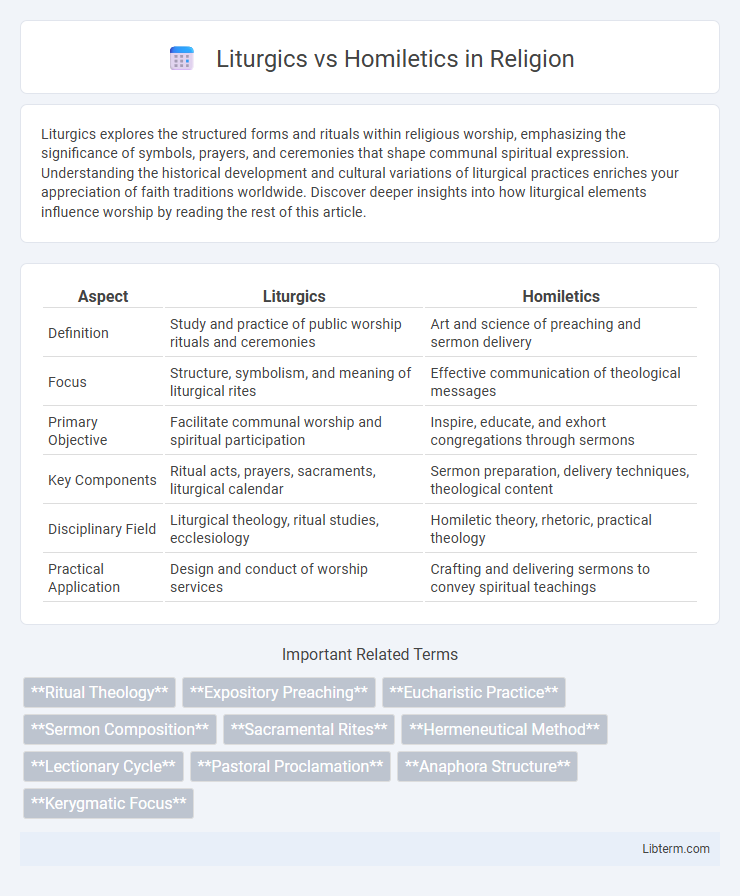Liturgics explores the structured forms and rituals within religious worship, emphasizing the significance of symbols, prayers, and ceremonies that shape communal spiritual expression. Understanding the historical development and cultural variations of liturgical practices enriches your appreciation of faith traditions worldwide. Discover deeper insights into how liturgical elements influence worship by reading the rest of this article.
Table of Comparison
| Aspect | Liturgics | Homiletics |
|---|---|---|
| Definition | Study and practice of public worship rituals and ceremonies | Art and science of preaching and sermon delivery |
| Focus | Structure, symbolism, and meaning of liturgical rites | Effective communication of theological messages |
| Primary Objective | Facilitate communal worship and spiritual participation | Inspire, educate, and exhort congregations through sermons |
| Key Components | Ritual acts, prayers, sacraments, liturgical calendar | Sermon preparation, delivery techniques, theological content |
| Disciplinary Field | Liturgical theology, ritual studies, ecclesiology | Homiletic theory, rhetoric, practical theology |
| Practical Application | Design and conduct of worship services | Crafting and delivering sermons to convey spiritual teachings |
Defining Liturgics: Understanding Worship Practices
Liturgics studies the structured rituals, ceremonies, and symbolic actions that form communal worship, emphasizing the arrangement and meaning of liturgical elements within various religious traditions. It involves analyzing the historical development, theological foundations, and cultural expressions of worship practices to enhance congregational participation and spiritual experience. Understanding liturgics helps clarify how worship services are designed to communicate and embody religious beliefs through prescribed forms and sacred rites.
Homiletics Explained: The Art of Preaching
Homiletics is the discipline that focuses on the art and science of preaching, emphasizing sermon preparation, delivery, and communication of biblical messages to congregations. It involves interpreting scripture effectively, crafting meaningful sermons, and employing rhetorical techniques to engage and inspire listeners. Unlike liturgics, which studies public worship practices and rituals, homiletics centers on the preacher's role in conveying theological truths through spoken word.
Historical Roots of Liturgics and Homiletics
Liturgics, rooted in early Christian worship practices, evolved from Jewish temple rituals and early church sacramental traditions, emphasizing communal worship and sacramental actions. Homiletics, emerging from the didactic teachings of the Apostles and early Church Fathers, developed as the art of preaching and sermon delivery to interpret scripture for congregational edification. Both disciplines trace their origins to the formative centuries of Christianity, reflecting distinct yet complementary roles in religious life and practice.
Key Differences Between Liturgics and Homiletics
Liturgics studies the structure and elements of public worship services, emphasizing rituals, prayers, and ceremonies that shape communal religious experiences. Homiletics focuses on the art and practice of preaching, including sermon composition, delivery techniques, and effective communication of religious messages. Key differences lie in Liturgics' concern with worship order and symbolism, while Homiletics centers on verbal proclamation and interpretation of scripture during sermons.
Theological Foundations of Liturgical Practice
Liturgics centers on the theological foundations of worship practices, emphasizing the symbolic and communal dimensions rooted in Scripture and tradition. It explores how rituals embody theological truths, fostering a sacred encounter with the divine through structured forms such as sacraments, prayers, and hymns. Homiletics, by contrast, concentrates on the art and theology of preaching, focusing on interpreting biblical texts to communicate doctrine and inspire faith within the worship context.
Crafting Effective Sermons: The Homiletic Approach
Crafting effective sermons within the homiletic approach emphasizes clear communication, biblical interpretation, and audience engagement to foster spiritual growth. Homiletics prioritizes structuring messages with persuasive rhetoric, theological depth, and practical application tailored to congregational needs. This method enhances sermon delivery by integrating scriptural exegesis and contextual relevance, optimizing impact on listeners' faith and understanding.
The Role of Scripture in Liturgics vs Homiletics
In liturgics, Scripture functions as a foundational element that shapes the structure and content of worship, ensuring that prayers, sacraments, and rituals align with biblical theology and convey the communal faith experience. Homiletics emphasizes Scripture as the primary source for sermon development, where biblical texts are exegetically analyzed to inspire, instruct, and apply theological truths directly to the congregation's daily life. Both disciplines rely on Scripture's authority, but liturgics integrates biblical passages within a corporate worship context, while homiletics centers on individual proclamation and interpretation.
Impact on Congregational Engagement
Liturgics shapes congregational engagement by structuring worship through rituals, symbols, and liturgical calendars, fostering a shared spiritual experience and active participation. Homiletics impacts engagement by crafting and delivering sermons that connect scriptural messages to the daily lives of congregants, stimulating reflection and personal application. The dynamic interplay between liturgical practice and preaching enhances meaningful involvement and deepens communal faith connections.
Modern Trends in Worship and Preaching
Modern trends in liturgics emphasize immersive, participatory worship experiences using multimedia technology, inclusive language, and culturally diverse expressions to engage contemporary congregations. Homiletics has evolved with a focus on narrative preaching, emotional resonance, and practical application, leveraging digital platforms and social media for wider reach and interaction. Both disciplines increasingly integrate interdisciplinary insights from psychology, communication studies, and sociology to deepen spiritual impact and community connection.
Integrating Liturgics and Homiletics in Ministry
Integrating liturgics and homiletics in ministry enhances worship by combining structured ritual practices with effective preaching, fostering a cohesive spiritual experience. Liturgics provides the framework for worship order and sacramental actions, while homiletics focuses on the art of sermon delivery and biblical interpretation. Together, they create a dynamic approach to ministry that nurtures congregational engagement, theological reflection, and communal worship life.
Liturgics Infographic

 libterm.com
libterm.com